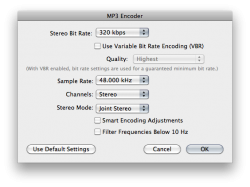Hi, I am sure this question must have been answered before, so please forgive me.
I have a new Nano 7 gen and have put selected playlists on it, as much as will fit on.
I have a pair of skullCandy headphones of medium quality,
If I reduce the bit rate down to 128 from iTunes 256, will there be a noticeable difference? I have tried 128 and cannot make my mind up if there is any difference!
I listen on the train with noise around me and was curious what you think and am I missing out on sound quality. Thanks
I have a new Nano 7 gen and have put selected playlists on it, as much as will fit on.
I have a pair of skullCandy headphones of medium quality,
If I reduce the bit rate down to 128 from iTunes 256, will there be a noticeable difference? I have tried 128 and cannot make my mind up if there is any difference!
I listen on the train with noise around me and was curious what you think and am I missing out on sound quality. Thanks



